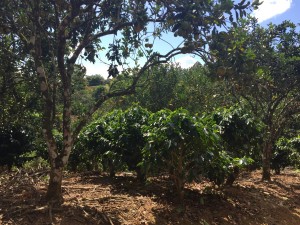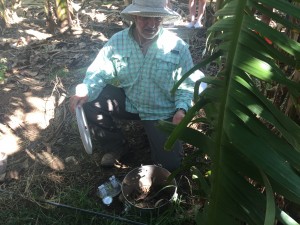My vision for our booth is having a table set up with a sort of prequiz that people will take when they first come to the booth. After completing this quiz they will take a “Walk Through Puerto Rico”. There will be three stations set up. They will have multiple monitors playing videos of our experiences while on our trip. The videos will be split up into the categories of beaches/coral reefs, our hiking adventures and agriculture. This video is an example of the kind of video that could possibly be displayed for the agriculture section. It discusses what we learned about coffee production while on our trip. The material is simplified so that all types of audience will be able to follow along. Each video will have a sort voice over with details about what is in the video as well as other sound effects to make it seem more realistic. After going through each station, the visitors will end at the final table. At this table there will be a blooper video playing with music. Also, there will be candy and students to talk with everybody. Maybe we could have other decorations to draw attention such as a hammock or coconuts what have you. I think that if we combine all of our talents together we will make an amazing booth to display at the open house.
Climate Change and its Effect on Coffee Production
For open house, I imagine us having three separate videos similar to the one above, each focusing on different topics. The three topics would include agriculture, beaches, and rain-forests. In the videos, we would present some crucial information we learned about each topic. More importantly, we must show some of the visually appealing points of our trips to engage and attract viewers. We will use the pictures and go pro videos we took to portray our ideas. In addition to the videos, we will set up the mood of each location. This includes adding sand and wave noises to the beach as well as waterfall and bird sounds to the rain-forest. We will try to transform the setting so people feel as if they were in Puerto Rico. To help accomplish this, we will show them transition videos including the plane ride to and from Puerto Rico and the car rides between the various locations. This will make the booth feel more realistic.
In order to add an educational portion to this, we will give the participants a pre-quiz and post-quiz about Puerto Rico and Illinois. The questions will cover topics presented in the booth. I imagine that we will need an interesting set up outside the tents to attract people to the booth (as they will not be able to see the inside with the videos). This could be decorating the tent outside to look like Puerto Rico and also showing the video we used at UPR. After taking the post-quiz we will give a quick debriefing, answer any questions, and show the interviews from UPR. I anticipate this booth attracting many people as it will be unique and engaging, but also informative.
Puerto Rican Surprises
When thinking of how to present this blog I thought about what would engage people the most. I think that people respond the best to visuals. The best way to fully experience a place without actually going there is to see videos or pictures of it. In this video I talked about what surprised me most when visiting Puerto Rico: The landscape. I included visuals of the three most extreme landscapes that we observed while traveling abroad. These three extremes were the mountains/rainforest, ocean/beach, and the farming flatlands. I found it interesting how the terrain changes interacted with each other in terms of agriculture. At Martex farms we were taught about how many of the farmers irrigate their fields with the water from the mountains and how the placement of the fields between the mountains and the oceans creates an ideal environment for farming and produces very fertile soil. Overall, I hope to give the open house visitors the best idea possible of what it is like in Puerto Rico. I believe that through strong communication and effective visuals we will be able to do that for our booth visitors.
Mike Romano Puerto Rico Blog 3
I took a different approach to this blog post, and made a blog that would represent a conversation I would have with a visitor at open house. I feel that our main goal at open house is to educate our visitors in creative and engaging ways. This blog post, I made a video of images I took during our visit to Cafe Gran Batey which was a coffee farm in Puerto Rico that produced very high quality coffee. Before the trip, I was unfamiliar with the process of harvesting and producing coffee. I feel like many of our visitors, especially kids, will also be unaware of the process and I think it is important to show them how it works considering the coffee industry in Puerto Rico is one of its largest. Basically, my vision for open house is to attract as many visitors as possible, and to explain to them our experience and what we learned. I feel that with a process like this video above, it will be easier for our audience to understand our experience through explanation with pictures. I feel that this type of video, along with our previous ideas we discussed as a group, I think we can effectively engage with our visitors and make it a fun experience for all of our visitors.
My experience in Puerto Rico
For the open house, I envision a walk through, maze-like both with many spaces separated by large sheets that are printed with different panorama pictures. Each panorama will be of a different location. One will be the mountains with the rainforest, another the beach and the coral reefs, and others for the coffee farm and the fruit plantation. We will further enhance the spaces by adding extras such as sand and a coffee plant. In each space there will be a monitor showing video from our experience in the different locations, integrated with or followed by brief educational information about each setting. In between each setting we will have other monitors and/or pictures showing the transitions for each place we visited. Those monitors will have video of the views we saw while in the van, fun music, and pictures of our apartment or Mayaguez. The last section will be discussing the University of Puerto Rico Mayaguez and our project there. The video will show our game, include segments of the interviews we conducted, and discuss our experience as a whole. Once the participants have left the booth we will sum up the experience and answer any questions that they have.
Agriculture Processes Comparison
Our EOH booth will be accessible and fun for all potential visitors. My vision is a booth with multiple forms of media throughout and an inviting display with the colors and cultural feelings of Puerto Rico infused throughout the booth. At the main table there will be multiple, approachable attendants inviting passerby’s into a trip through Puerto Rico. Once a visitor decides to check out our booth we will show them the displays playing multiple videos covering three varied topics which will encompass our journey. As they look at the topics they can walk up to the monitor to learn more. At the monitor they will put on headphones and learn more about the topic. At the monitor there will be panorama dividers which will be displaying images of Puerto Rico. These dividers will help the visitor be fully emerged in the Puerto Rico Experience. In addition to these stations, we will also have a monitor playing the interviews we conducted in Puerto Rico. These interviews touched on Illinois vs Puerto Rico as well as the importance of maintaining the environment. Finally, we will be there to give further information to visitors who have further interest or questions. Our booth will help educate visitors, while letting them enjoy themselves and providing the potential for further involvement.
Educating kids at EOH
I think the most important aspect of what we could be taking from the course is the sustainability part. I want parts of the booth to focus on how sustainable the systems of Puerto Rico and Illinois are. I’ve always been a guy rooted into nature and to me I got to experience one of the most beautiful pieces of scenery that a person could witness. I think we shouldn’t take it for granted and I think we should let the kids at EOH know that even though we had fun, we only had fun because we were surrounded by all of the nature. It’s much more important to me that they get an educational experience rather than a fun one. It would obviously be best to combine the two but I would prefer them to leave with a thought like “man, I want to visit Puerto Rico but I want to see it in all of its glory.” Because unfortunately money can be a bigger influence on some areas than trying to preserve the beauty of nature. At the end of it I want us to be able to focus on the aspects of our trip that really made us appreciate it and want to go back.
A New Vision
As a student I find things easier to understand and pay attention too if I am interested. So, for this booth I think it is important that we do our best too spark the interest of our visitors. That is what I have tried to do with my video, I want to draw the viewer in with an explanation of our fun adventures and then follow up with the main topic of our trip: agriculture. With this in mind I want to explain how I want the booth to be set up. First of all I want big Puerto Rican and University of Illinois flags hanging above our booth and carnival barkers spread out in front of the booth attracting visitors. Once we have visitors I envision the booth being a three part tour. The first two sections being virtual tours of our adventures in El Yunque and our snorkeling trip. I want to use all the footage we have of our trip and monitors to make it seem as though they were on the trip with us. The final part of the booth is a crash course of Illinois and Puerto Rican agriculture. We are going to use pictures and facts we learned from the different farms and have a little quiz game at the end of the booth to give the participants a chance to win a small prize. I plan to make this booth a huge success and hope that people of all ages can enjoy.
Local realities of global issues
Global climate change is uniquely affecting all places around the world. Living in Illinois, I can conceptualize the causes of climate change and read about the s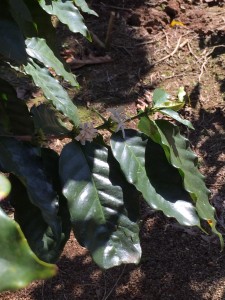 evere weather events occurring around the world, and I can detect that the seasonal variations are not quite the same, but I cannot truly understand the gravity of the effects of climate change until I hear about them first hand from those experiencing them and suffering their consequences.
evere weather events occurring around the world, and I can detect that the seasonal variations are not quite the same, but I cannot truly understand the gravity of the effects of climate change until I hear about them first hand from those experiencing them and suffering their consequences.
Visiting Puerto Rico, I had that eye-opening experience. At the small family owned coffee farm in Puerto Rico, Café Gran Batey, the owner’s son reflected on climate change causing significant reductions in coffee yields with the this year and last year their lowest coffee yields on record. Yield has drastically decreased because of changes in a climatic pattern essential for coffee growing.
Puerto Rico has a dry season and a wet season. In the early months of the year, the dry weather allows for the coffee plant flowers to open and be pollinated. Then, in the later months of the year, the wet weather is essential for the coffee bean to grow and hold in moisture. However, climate change has flip flopped the seasons. More rain at the beginning of the year is knocking off the flowers and not allowing them to open for pollination. Less rain at the end of the year is producing coffee beans with dry centers.
The truth of the owner’s son concern about climate change became even more evident in the storage room where there were few bags filled with coffee beans compared to the amount of space available. Making the connection between the weather causes and the almost empty storage room, I reflected further on society’s dependence on agriculture for goods, and the potential extent of economic 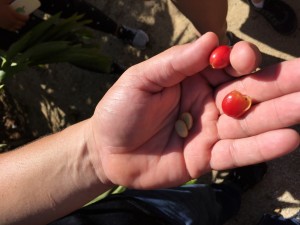 and food availability consequences for producers and consumers.
and food availability consequences for producers and consumers.
The severity of climate change and its effects on agriculture, however, did not discourage me. Instead it reaffirmed for me that solving global issues in agriculture would require developing dynamic regional solutions for regional climatic and agricultural variations.
Before coming to Puerto Rico, I was curious to find out the status of conservation, including their methods of conservation and how much land is protected. At El Yunque National Forest, I was happy to find that their educational materials discussed the interdependency of different species in an ecosystem and of people on ecosystems. Then, at Hacienda Buena Vista, I was impressed by their mission to preserve biodiversity and historical sites and their ideal of susta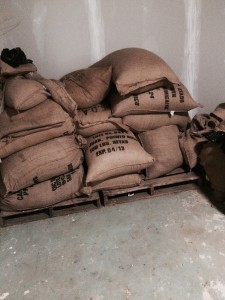 inable agriculture as well as their focus on education.
inable agriculture as well as their focus on education.
All of my questions about Puerto Rico’s status on conservation and sustainability have yet to be answered. I want to find more quantitative data about energy, recycling, and biodiversity that my observations cannot provide. My observations still have allowed me to reflect on global sustainability, especially when comparing Illinois with Puerto Rico. From my experience in Illinois, I know that it is still developing in many areas of sustainability, and much work as well as research needs to be done to both implement and improve programs. Puerto Rico is in the process of development too. Puerto Rico has showed me further that all places around the world are at different stages of achieving sustainability and that achieving sustainability will require collaborative effort from all fields on a local level.
With a few more days left in PR, I am anxious to ask more questions and experience more of the island. I am especially excited to ask students at the University of Puerto Rico-Mayaguez about their perspectives on sustainability, and, having enjoyed PR so much myself, I am curious to know what they especially like about the island.
Farms in Puerto Rico
Visiting farms is one of the most exciting part of the journey for me. It is planned and designed to enhance our understanding about agricultural sustainability. During the second week of the trip, Dr. Rodriguez brought us to several coffee and fruit farms around the island.
The first farm we visited was Hacienda Buena Vista up in the mountain. It is no longer in operation but it is preserved as a historical site where people are welcomed to learn coffee production and agricultural conservation. During the trip, I learnt to distinguish coco trees and cacao trees and the mechanics involved in coffee production. Coffee beans are peeled off from the outer layers by a machine using friction, and are consequently grinded using the grinding machine powered by hydraulic power. The grinding machine was specially designed for the farm, and there is only one such machine in the world. To ensure ample water supply in the farm, water is channeled from mountain down to the farm with an elevation about a thousand feet. As we were climbing up to the high end of the farm, we came across a few small entries by the water channel, and the guide told us that those were designed for child slaves to get in and clear the roots and soil that clogged the water channel. Slaves were commonly involved in agriculture activities and provided cheap labor service during old time in Puerto Rico. Enslavement is no longer exist today, but labor has become an expensive resource today.
On the visit of the second coffee farm—Café Gran Batey in Utuado, I learnt about more issues related to Puerto Rican agriculture. This farm is one of the major coffee producer for the local market. Different from Hacienda Buena Vista, it does not have large canopy of trees to provide shading for coffee trees, so the farm grows citrus trees next to coffee trees to create artificial shades. The purpose of the shade does not only reduce the extent of sunlight but lengthens the growth period for better quality coffee. When the coffee beans reap, the farm hires local workers to pick them. The owner of the farm told us that it is difficult to hire workers to pick coffee beans nowadays because local labors need less incentive to work with the unemployment welfare from the state. On average, those workers work for three to four hours a day in mornings. As compared to other parts of the U.S, agricultural industry in Puerto Rico is more dependent on human labors given the different types of crops grown and geographical challenges in Puerto Rico. Automation and large off-road machineries are not as applicable in fruit plantations as in flat corn fields. Unfortunately, less people among the younger generation are willing to work on farms, and the agricultural industry that thrived Puerto Rican economy is now in a decline. To help the agricultural industry be more efficient and economic, traditional agriculture that is labor intensive is expected to shift to machinery-led modern agriculture. Besides labor, agricultural activities are also highly depended on weather. Last year, the overall coffee production reached an all-time low and fell short of the local coffee demand because of the off rain and dry season. Although agricultural engineering can help farmers in many ways, there is a limit when it comes to the nature. At the end of the trip, we sipped in a cup of coffee accompanied with a piece of pound cake in the mountain. It was an very enjoyable experience!
After learning about coffee production, we had a chance to study nutrient loss in plantain farm and visit the packaging factory in Matex fruit farm. In the plantain field, Dr. Perez who is an Agricultural and Biological Engineering professor in the Mayaguez University introduced us the method to detect the nitrogen concentration in the soil and air. The purpose of the project he is leading is aimed to help plantain farmers find the most sustainable recipe for the plants and surroundings. From this experience, I realized the importance of agricultural and biological engineering in the society as it helps to solve and improve the most primary and fundamental industry in the world — agricultural industry. After watching the demonstration of collecting air samples, we headed to the package factory in the farm. All the plantains are consumed locally but fruits like mangoes and Spanish lemons are exported to other parts of America and European countries for higher profits. The farm also installed a lot of solar panels were installed with the help of government funding, such action promotes sustainability and reduces electricity bill in operation. From the farm manager, we learnt that the farm has been operating for twenty seven years, but it took five to ten years to start making profits. It really takes a lot of capital and determination to start up a farm. Agricultural industry is primary but it is not necessarily lucrative. Regardless, I hope more young people will step into agriculture with more help and encouragement from the state and the older generation.


